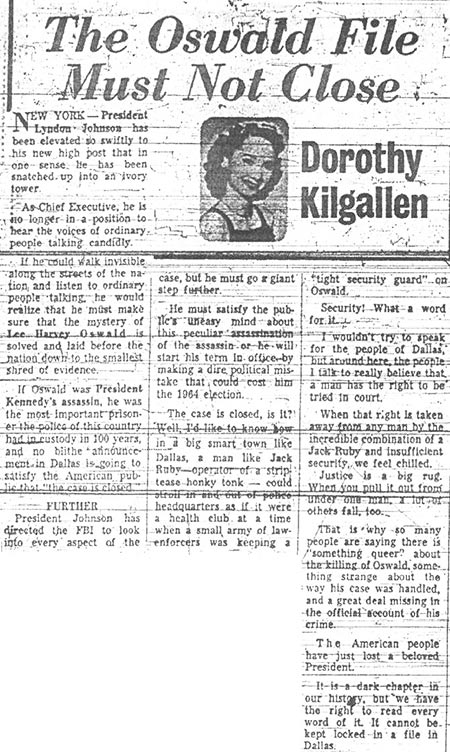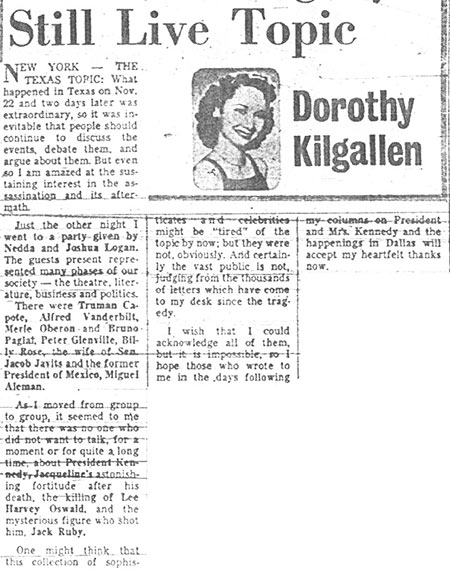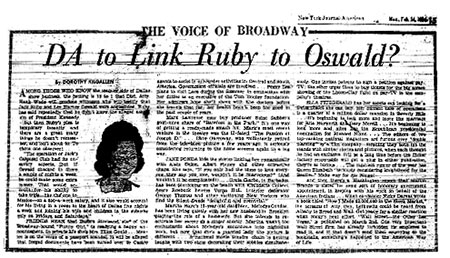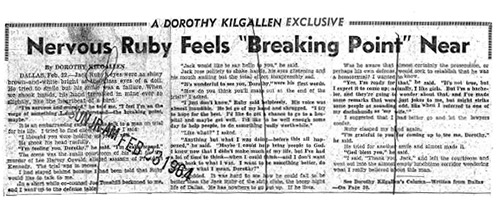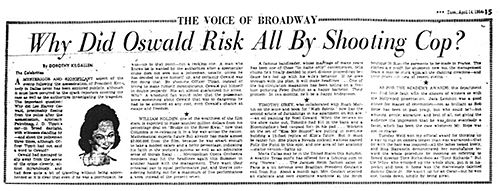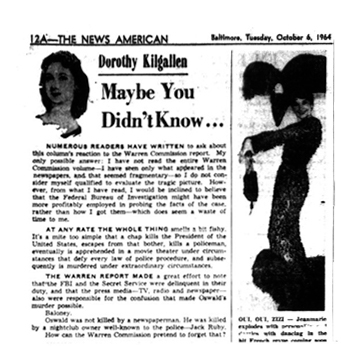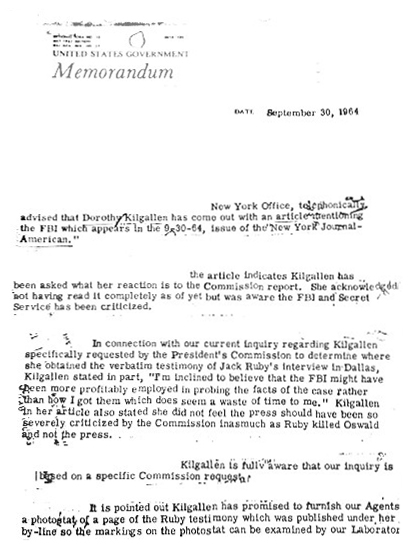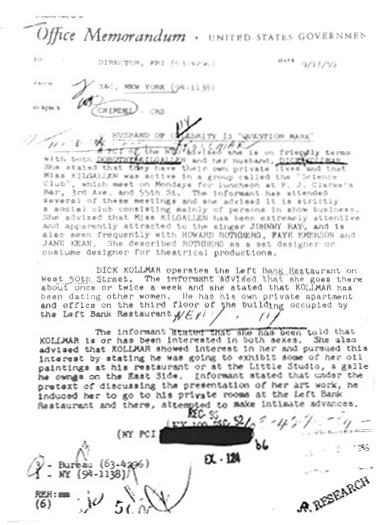Newspaper Columns and Articles Pertaining to
Dorothy Kilgallen & JFK
- Column Pertaining to Death of Marilyn Monroe – August 5, 1962
- 1956 Column, “The Real Frank Sinatra Story,” Pertaining to Singer Sinatra, with whom Kilgallen had a Feud for Several Years
- Column Pertaining to Dr. Sam Sheppard Murder Trial (Case became the film, “The Fugitive,” starring Harrison Ford)
- Oswald File Must Not Close” Kilgallen Column – November 29, 1963
- “Still Live Topic” Kilgallen Column – December, 1963
- “DA to Link Ruby to Oswald” Kilgallen column - Feb. 1964
- “Nervous Ruby Near Breaking Point” Column – Feb. 1964
- “Why Did Oswald Risk All by Shooting Cop?“ Column – April 4, 1964
- Journal-American Headline: “Stories Quote Ruby Saying Slaying Was His Own Idea.” (Dorothy Exclusive – Printed Jack Ruby Warren Commission Before its Release Date) - August 9, 1964
- “Maybe You Didn’t Know” Kilgallen column – October 4, 1964
- In a subsequent column entitled, “Search for the Truth,” Dorothy observed in part:
- FBI Memorandum dated September 17, 1959 – Included in The Reporter Who Knew Too Much
- FBI Memorandum dated September 30, 1964 – Included in The Reporter Who Knew Too Much
1. Column Pertaining to Death of Marilyn Monroe – August 5, 1962
If the woman described as Marilyn’s “housekeeper” [Eunice Murray] is really a housekeeper, why was [Marilyn’s] bedroom such a mess? It was a small house and should have been easy to keep tidy.
Why was Marilyn’s door locked that night, when she didn’t usually lock it? If she was just trying to get to sleep and took the overdose of pills accidentally, why was the light on? Usually people sleep better in the dark.
Why did the first doctor [arriving on the scene] have to call the second doctor before calling the police? Any doctor, even a psychiatrist, knows a dead person when he sees one, especially when rigor mortis has set in and there are marks of lividity on the surface of the face and body. Why the consultation? Why the big time gap in such a small town? Mrs. Murray gets worried at about 3 a.m. and it’s almost 6 a.m. before the police get to the scene.
The real story hasn’t been told, not by a long shot. Sleep well, sweet girl. You have left more of a legacy than most, if all you ever left was a handful of photographs of one of the loveliest women who ever walked the face of the earth.
2. 1956 Column, “The Real Frank Sinatra Story,” Pertaining to Singer Sinatra, with whom Kilgallen had a Feud for Several Years
After detailing Sinatra’s various romances with, among others, Gloria Vanderbilt, Kim Novak, Lana Turner and Ava Gardner, Dorothy wrote:
A few of [Sinatra’s] women, like Ava and Lana, were public idols themselves and priceless examples of feminine beauty. Many more, of course, have been fluffy little struggling dolls of show business, pretty and small-waisted and similar under the standard layer of peach-colored Pan-Cake makeup. [They are] starlets who never got past first base in Hollywood, assorted models and vocalists, and chorus girls now lost in the ghosts of floor shows past. Others belonged to the classification most gently described as tawdry.
3. Column Pertaining to Dr. Sam Sheppard Murder Trial (Case became the film, “The Fugitive,” starring Harrison Ford)
Describing Dr. Sheppard, Dorothy wrote:
As he walked with the deputy sheriff across the leaf-covered awn, their wrists were so close the handcuffs barely showed, he was hatless and ramrod straight in a light brown and tan small-checked topcoat. Burberry style, which he wore unbuttoned. Except for the stern set of his jaw and his pallor, he looked almost collegiate; he might have been, standing in the icy wind, not seeming to notice it, the local high school’s football coach. Regarding how Sheppard’s dead wife Marilyn appeared in court photos, Kilgallen wrote: She was beautiful. So lovely and so bruised. So gentle looking, with her eyes closed, sleeping under the vermillion gashes... No picture ever printed of Marilyn Sheppard... has shown her to be as lovely as she was in death—discolored and slashed and broken.
4. Oswald File Must Not Close” Kilgallen Column – November 29, 1963
Excerpt:
President Lyndon Johnson has been elevated so swiftly to his new high post that in one sense, he has been snatched up into an ivory tower. As Chief Executive, he is no longer in a position to hear the voices of ordinary people talking candidly. If he could walk invisible along the streets of the nation and listen to ordinary people talking, he would realize that he must be sure that the mystery of Lee Harvey Oswald is solved and laid before the nation down to the smallest shred of evidence.
If Oswald is President Kennedy’s assassin, he is the most important prisoner the police in this country had in 100 years and no blithe announcement in Dallas is going to satisfy the American public that the case is closed.
President Johnson has directed the FBI to look into every aspect of the case, but he must go a giant step further. He must satisfy the public’s uneasy mind about this peculiar assassination of the assassin or he will start his term in office by making a dire political mistake that can cost him the 1964 election.
The case is closed, is it? Well, I’d like to know how, in a big, smart town like Dallas, a man like Jack Ruby—owner of a strip tease honky tonk—can stroll in and out of police headquarters as if it was at a health club at a time when a small army of law enforcers is keeping a “tight security guard” on Oswald. Security! What a word for it.
I will not try to speak for the people of Dallas, but aroundhere, the people I talk to really believe that a man has the right to be tried in court. When that right is taken away from any man by the incredible combination of a Jack Ruby andinsufficient security, we feel chilled. Justice is a big rug. When you pull it out from under one man, a lot of others fall too.
That is why so many people are saying there is “somethingqueer” about the killing of Oswald, something strange about the way his case was handled, a great deal missing in the official account of his crime. The American people have just lost a beloved President. It is a dark chapter in our history, but we have the right to read every word of it. It cannot be kept locked in a file in Dallas.
5. “Still Live Topic” Kilgallen Column – December, 1963
Excerpt:
What happened in Texas on Nov. 22 and two days later is extraordinary, so it is inevitable that people should continue to discuss the events, debate them, and argue about them. But even I am amazed at the sustaining interest in the assassination and its aftermath.
Extolling her propensity for mixing with the rich and famous, Kilgallen then wrote of a party she attended. Stage and film director Joshua Logan (Picnic, Bus Stop) hosted. The guests included celebrated author Truman Capote, wealthy sportsman Alfred Vanderbilt, American impresario, theatrical showman and lyricist Billy Rose (Me and My Shadow), and the former president of Mexico.
She wrote:
As I moved from group to group, it seemed to me that there was no one who did not want to talk, for a moment or for quite a long time about President Kennedy, Jacqueline’s astonishing fortitude after his death, the killing of Lee Harvey Oswald, and the mysterious figure who shot him, Jack Ruby. One might think that this collection of sophisticates and celebrities might be “tired” of the topic by now, but they were not obviously.
6. “DA to Link Ruby to Oswald” Kilgallen column - Feb. 1964
Excerpt:
Among those who know the seamier side of Dallas show business, the betting is 10 to 1 that Dist. Atty. Hank Wade will produce witnesses who will testify that Jack Ruby and Lee Harvey Oswald were acquainted. Ruby has said repeatedly that he didn’t know the alleged assassin of President Kennedy—but thenRuby’s plea is temporary insanity and there are a great many things he doesn’t remember, and isn’t about to.
To quote one observer, “the operation of Jack’s Carousel Club had its unsavory aspects but if Oswald checked in there a couple of nights a week, he could have made some extra money. That would account for his ability to take trips—like the one to Mexico—on a $50-a-week salary, and it also would account for his lying in a room in the heart of Dallas five nights a week and joining his wife and children in the suburbs only on Fridays and Saturdays.
7. Nervous Ruby Near Breaking Point Column – Feb. 1964
Excerpt:
Jack Ruby’s eyes were as shiny brown-and-white bright as the glass eyes of a doll. He tried to smile but his smile was a failure. When we shook hands, his hand trembled in mine ever so slightly, like the heartbeat of a bird.
I’m nervous and worried,’ he told me. ‘I feel I’m on the verge of something I don’t understand—the breaking point maybe.’” When Kilgallen told Ruby “I think you’re holding up pretty well,” he replied, “I’m fooling you Dorothy. I’m really scared.
I had stayed behind because I had been told that Ruby would like to talk to me. In a short while co-counsel Joe Tonahill beckoned to me, and I went up to the defense table. ‘Jack would like to talk to you,’ he said. Jack rose politely to shake hands, his eyes glistening and his mouth smiling but the total effect inexpressively sad. It’s wonderful to see you Dorothy,’ were his first words...
I went out into the almost empty lunchroom corridor wondering what I really believed about this man.
8. “Why Did Oswald Risk All by Shooting Cop?” Column – April 4, 1964
Excerpt:
A mysterious and significant aspect of the events following the assassination of President Kennedy in Dallas has never been explored publically, although it must have occurred to crack reporters covering the case as well as authorities investigating the tragedies. The important question—why did Lee Harvey Oswald, presumably fleeing from the policeafter the assassination, approach Patrolman J. D. Tippit’s car—in broad daylight with witnesses standing by—and shootthe policeman three times, although he had not said a wordto Oswald.
Oswald had managed to slip away from the scene and was—up to that point—not a reckless one. A man who knows he is wanted by the authorities after a spectacular crime does not seek out a policeman usually, unless he has decided to givehimself up, and certainly Oswald was not doing that. By shooting Tippit instead of trying to make himself inconspicuous,Oswald put himself in double jeopardy. His act almost guaranteed his arrest. Why? A whodunit fan would infer thatthe policeman knew something about Oswald that was sodangerous [the policeman] had to be silenced at any cost, even Oswald’s chance at escape and freedom.
9. Journal-American Headline: “Stories Quote Ruby Saying Slaying Was His Own Idea.” (Dorothy Exclusive – Printed Jack Ruby Warren Commission Before its Release Date) - August 9, 1964
What you are about to read is the transcript of the testimony given by Jack Ruby to Chief Justice Earl Warren and other members of the Warren Commission investigating the assassination of President Kennedy.... The transcript is 102 pages long and is a word-by-word account of the three-hour, five-minute interrogation of Jack Ruby—the third member of a triangle that has become an irrevocable part of history.
Jack Ruby, in a purported secret testimony givento the Warren Commission, said it was strictly his own idea to kill Lee Harvey Oswald, accused assassin of President Kennedy. In a copyrighted story Tuesday by Journal-American columnist Dorothy Kilgallen, Ruby was quoted as having told Justice Warren June 7, I was never malicious toward this person. No one else requested me to do anything. I never spoke to anyone about attempting to do anything. No subversive organization gave me any idea. No underworld persons made any effort to contact me. It all happened that Sunday morning.
10. “Maybe You Didn’t Know” Kilgallen column – October 4, 1964
Excerpt:
“From what I have read, I would be inclined to believe that the FBI might be more profitably employed in probing the facts of the case rather than how I got them—which does seem a waste of time to me.
“At any rate, the whole thing smells a bit fishy. It’s a mite too simple that a chap kills the President of the United States, escapes from that bother, kills a policeman, eventually is apprehended in a movie theater under circumstances that defy every law of police procedure, and subsequently is murdered under extraordinary circumstances.
“The Warren report made a great effort to note that the FBI and the Secret Service were delinquent in their duty, and that the press media—TV, radio and newspaper—also were responsible for the confusion that made Oswald’s murder possible. Baloney. Oswald was not killed by a newspaperman. He was killed by a nightclub owner well-known to the police—Jack Ruby. How could the Warren Commission pretend to forget that.
11. In a subsequent column entitled, “Search for the Truth,” Dorothy observed in part:
“[The Warren Commission Ruby testimony] is a fascinating document—fascinating for what it leaves unsaid, as well as what it says.
Commenting on Ruby’s state of mind, she added:
“He opened the floodgates of his mind and unloosed a stream of consciousness that would have dazzled a James Joyce buff and enraptured a psychiatrist. There was a great deal of fear inside Jack Ruby that Sunday in June [when he testified]. He feared for his own life, he feared for the lives of his brothers and sisters.
“It seemed to me after reading the testimony three times that the Chief Justice and the general counsel were acutely aware of the talk both here and in Europe that President Kennedy was the victim of a conspiracy. They took pains to prove to themselves and the world that no conspiracy existed.
12. FBI Memorandum dated September 30, 1964 – Included in The Reporter Who Knew Too Much
13. FBI Memorandum dated September 17, 1959 – Included in The Reporter Who Knew Too Much


